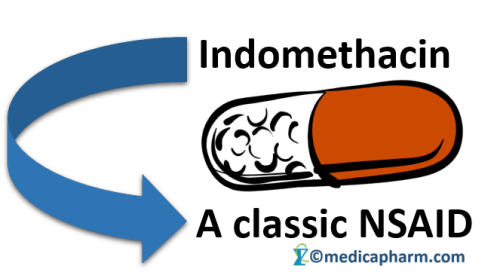NSAIDs are a good choice to overcome cold and flu after natural cure with vitamin C. That’s how the NSAIDs are remembered, because of their usage for cold and flu. Simply because they are valuable allies against cold and flu. Have you ever heard about an NSAID called Indomethacin?! Whether yes or no, I would like to refresh up some informations. Afterwards, it’s easy to get to know Indomethacin especially if the name sounds new to you.
First of all, NSAIDs stands for Non Steroidal Anti-inflammatory Drugs. They are famous enough for being widely used to counteract many symptoms and pain. Among the most particularly known NSAIDs are: Ibuprofen, Ketoprofen and Diclofenac. They could be used in general as anti-inflammatory agents and for their pain killing actions. I recommend reading these articles for full understanding: Prostaglandins and NSAIDs.
Indomethacin is a member of the NSAIDs family, renowned for its potential action. The main classification of NSAIDs is either classic or newer. Indomethacin belongs to the classic ones.They are also called non selective or traditional NSAIDs. It’s significant to know that the non selective NSAIDs are not capable of differentiating between cox enzymes. Other traditional/classic NSAIDs include Naproxen, Ketoprofen and Aspirin.
Indications of Indomethacin
Indomethacin acts as anti-inflammatory, anti-rheumatic, antipyretic, and analgesic. It causes a remarkable decrease in the synthesis of prostaglandins (PGs). It is used mainly for the treatment of moderate to severe kinds of pain. Frankly speaking, due to being a classic NSAID, using newer NSAIDs instead is much better. That’s because of the selectivity which accurately defines the medication orientation. Selectivity is important too for the avoidance and/or diminishing of side effects. However, yet, Indomethacin is used for some kinds of pain. Let’s have a look,
Check out: what are the prostaglandins?
Osteoarthritis
Indomethacin is perfect for the pains accompanying osteoarthritis, the arthritis due to the joints lining breakdown. The most prominent of those pains are swelling and stiffness of joints.
Rheumatoid arthritis
This is a type of arthritis in which there is swelling of the lining of the joints.
Acute gouty arthritis/Gout
Severe pain in joints when the uric acid builds up in them. It occurs if the body can not get rid of enough uric acid. So that uric acid crystals are formed in the joints. Immediate-release capsule, suspensions and suppositories are the most used dosage forms in this case.
Ankylosing spondylitis
An arthritis where the spine/backbone is greatly and majorly affected.
Tendonitis/Tendinitis
This is the inflammation of tendons, the tissues connecting muscle to bone. Indomethacin is one of the medications with great efficacy against tendonitis.
Bursitis
The shoulder joint contains a sac filled with fluid. When this sac is inflammed, it is called bursitis. Indomethacin can greatly relieve bursitis.
Others
Indomethacin could also be used for different sorts of pain, fever and inflammation occurring along with injuries.
Side effects of Indomethacin
- Dizziness
- Constipation
- Headache
- Vomiting
- Diarrhea
Contraindications/Indomethacin should not be used in cases of:
- Pregnancy and lactation
- Children under 14 years old
- Hypersensitivity/Allergy to Indomethacin
- GIT/Gastrointestinal tract lesions or a history of recurrent GIT disease
Signature
To be taken as directed by the doctor. Otherwise, 2-3 times daily for a dose of 25 mg is the initial dose. The maximum daily dose should not exceed 200 mg.

